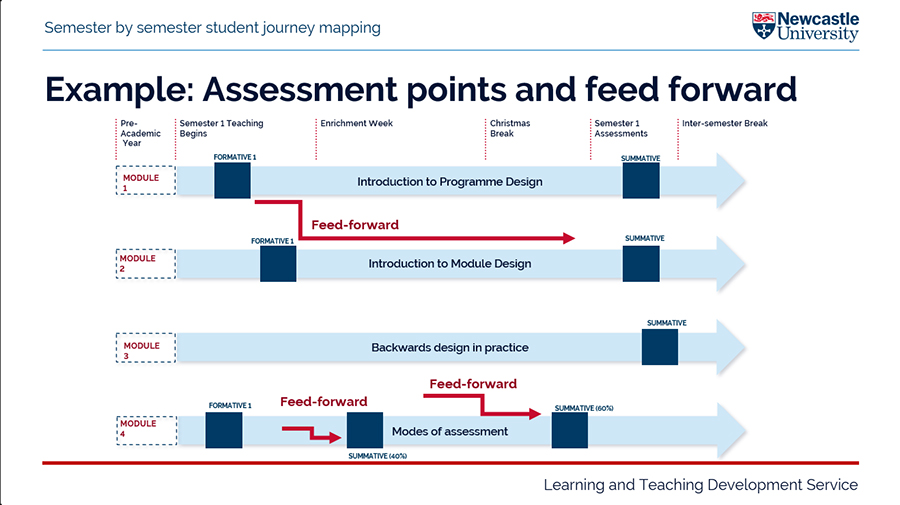Programme Focussed Assessment
NEW: A vision for education and skills at Newcastle University: Education for Life 2030+
Introduction
Most of our taught programmes at Newcastle University are modular, they are comprised of modules which are assessed as individual units. The modular system brings advantages of flexibility and efficiency, but it can lead to a compartmentalised approach to learning where students struggle to see the connections between their learning across modules.
To avoid these pitfalls, we recommend adopting a ‘programme focussed approach’ in which assessments in individual modules have a clear relationship to programme level outcomes and are considered part of the overall student journey. A programme focussed approach involves the programme team working together to adjust and adapt modular assessments. In doing so, a programme focussed approach can help prioritise and support student learning, reduce assessment burden and make assessments more inclusive. As a programme team you should also want to consider our University Framework for Assessment Design as this provides some key principles, including those related to programme focussed assessment. A few of these are summarised below.
1. Assessments at module level contribute to programme level learning outcomes.
As part of programme approval your programme specifications detail how therefore useful as a programme team to revisit these aims and outcomes and ensure they still align. A useful starting point is to revisit the assessment mapping of intended learning outcomes that you completed as part of your programme specification and consider:
At module level:
- Which module learning outcomes are assessed?
- How do your assessments contribute to the programme level learning outcomes?
- How do you communicate the relevance of assessments to students?
At programme level:
- Do the module assessments contribute to the programme aims/objectives?
- Are their gaps? Are some areas over-assessed?
2. The links between assessment tasks across the stage / programme are clear to students
Before coming to university, students will have been accustomed to studying separate subjects that are assessed independently. Consequently, they may not necessarily perceive that feedback from one module is applicable to another later in the programme.
At module level:
- Point students back to preceding assignments where feedback will be relevant
- Emphasise the relevance of feedback/feedforward for future modules
- Demonstrate how assessed skills will be built upon later in the programme
Remember, by completing the assessment mapping, step 1 above, you will have a better idea of the assessments across the programme and will therefore be able to advise students on how this feedback links to their development at a programme level.
At programme level:
- Decide on a standard approach for Assessment Briefs across the programme as this will promote transparency, fairness and effective learning – see our guidance on
- Writing an Effective Assessment Brief
- Use common language in assessment criteria/rubrics for linked tasks – see our guidance on Writing Assessment Criteria and Rubrics. Support assessment literacy by clarifying language used in assessment tasks and in marking criteria
- Give students opportunities to work with the assessment criteria, for example, self-assess/peer assessment to help them understand the assessment criteria
- Periodically, work with students to construct rubrics or check the language used
3. The assessment mix supports student skill development.
Incorporating a variety of assessment methods, such as problem-solving exercises, presentations and group projects accommodates diverse learning styles and encourages a deeper understanding of the subject matter. Authentic assessments mirror real-world challenges and promote the development of practical skills that prepare students for future professional roles.
At programme level:
- Is there variety in the assessment methods?
- Do these give students opportunities to practice and develop key graduate skills (e.g., knowledge application; collaboration; communication; professional skills; career management?)
- Are there opportunities to adjust assessment types used in some modules to achieve a more appropriate mix?
4. Assessment are spaced so that students have opportunities to reflect and act on feedback
Effective feedback is crucial to learners’ development. Providing timely and meaningful feedback helps students understand their progress, make informed improvements, and actively engage in the learning process. Feedback is an element of learning that is frequently criticised by students in the NSS. Common criticisms of feedback are its timeliness (i.e., whether a student has an adequate period to reflect and respond to feedback before their next assessment) and its capacity to assist learning and development.
At module level:
- Is there adequate time for students to respond to feedback on assessment over the module?
At programme level:
- Does the timing of assessments and feedback make it possible for students to act on feedback from modules that further develop skills?
You may also find it helpful to read our guidance on What Makes Good Feedback.
5. Assessment workload for students is manageable across the programme/stage
An essential component of good programme focussed assessment design, is to consider assessment patterning and scheduling at a programme level. If assessments are bunched in a short period of time, this can affect real learning opportunities and will create unnecessary stress for students. Possibly resulting in an increase of requests for extensions. This can be a difficult balancing act for programme teams.
Some suggestions and how you might approach this as a team at a programme level.
Map assessments over each semester and stage so that you can visualise and evaluate the workload from a student perspective and consider the following:
- Are assessments evenly balanced across semesters and stages? Is there unnecessary bunching? If so, can assessment deadlines be modified to level student workload
- Is there too much emphasis on summative without sufficient formative opportunities?
- Is the workload associated with assessments appropriate in terms of assessment tariff? If all modules are at the higher end of the assessment tariff could some be adjusted? Are there opportunities for low stake assessment?
- Does your discipline allow for variety of assessment types, if not why and how could you overcome that?
- Are there opportunities for authentic assessment?
- Are there opportunities for assessment feedback to feedforward?
- Do the assessments at a modular level contribute to the programme outcomes?
We have provided a Semester by Semester Student Journey Mapping resource to help you visualise what the assessment journey looks like for your students. Your PS Education Team will be able to generate a report from Business Warehouse (SAP) to act as a starting point, using the assessment information recorded in MOFS.
You can also use physical or virtual post-its notes to mark programme-level assessment, stage by stage, on a timeline (example Miro from a concluded AESSC project).

6. The programme team negotiate shared feedback practices
Some variation in feedback mechanisms across a programme will be normal, e.g., some colleagues may like to use audio feedback on some assessments. However, students will be supported to find and engage with feedback if there is some commonality in tools and approaches:
- Using common assessment tools – if some colleagues mark using Turnitin and others use SpeedGrader, students will need to use different interfaces to access feedback. Having a consistent approach will support students.
- Agree on a consistent method of structuring feedback – e.g., where rubrics are used, will students expect to see comments next to each rubric element, or should they focus on the overall assessment comments?
How to review assessments on your programme
We recommend a five-stage process:
- Student Experience: find out more from your students about how they experience assessment on your programme.
- Audit: identify every assessment required in the core modules (A starting point could be BW report from MOFs)
- Map assessments: against programme learning outcomes over time.
- Evaluate: Use the prompts from the principles above to evaluate the assessments from a programme perspective.
- Re-design: change assessments at the modular level to ensure an effective programme approach.
Communicating a programme view of assessment
The maps and audits you construct during your review can be used to create student friendly documents and diagrams communicating the programme assessment journey. You could:
- Present a list of assessments for each stage with a brief narrative
- Create an assessment or programme journey map
See our blog post on Visualising Programme Level Assessment for examples.
